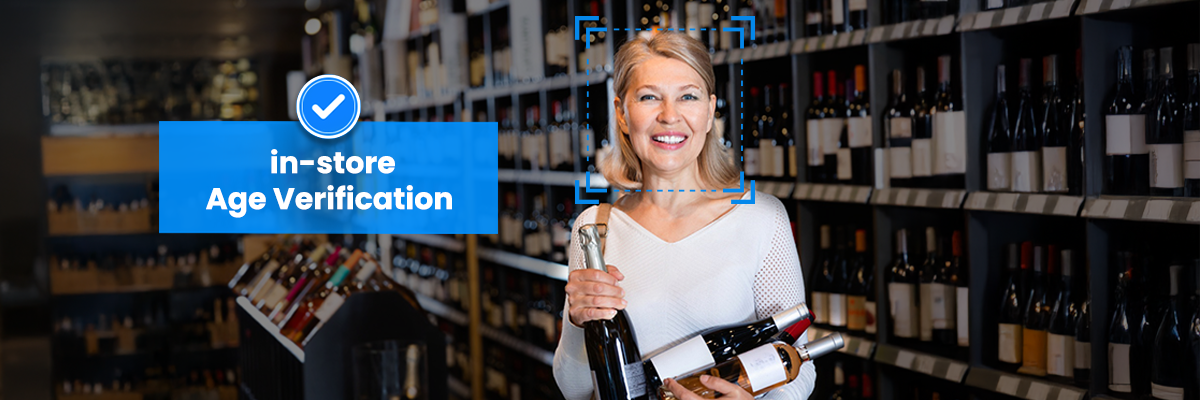How do age-restricted websites keep underage users off their sites?
In the past, age gating was used to prevent underage users from accessing age-restricted content. However, age gates are generally ineffective. Today, more businesses are turning to true online age verification systems to meet compliance.
What’s the difference between age gating and age verification?
Simply stated, age gating uses a checkbox system and asks a user if they’re the correct age. Age verification, on the other hand, offers a more comprehensive approach and requires users to prove they are a certain age (often by verifying documents online).
Let’s take a closer look so you can understand the key differences, as well as ways businesses stay ahead of the curve in online age verification.

What Is Age Gating & Age-Gated Content?
Age gating is used to restrict access to certain content or features on a website. Its main purpose is to keep minors from seeing or interacting with content that isn’t appropriate for their age group. This includes things like explicit material, mature video games, or content related to alcohol.
These systems typically require:
- Birthdate Verification: Age gating usually means users have to enter their birthdate to confirm their age. This method is widely used on websites selling age-restricted products like alcohol or tobacco.
- Checkbox Confirmation: Some websites utilize a checkbox confirmation system where users need to confirm that they are of a certain age or older to access particular content.
Ultimately, age gating is less secure, as users can easily bypass it by lying about their age. This ineffectiveness is a primary reason why many states have established age restriction laws for pornography websites.
While it serves as a reasonable protective measure, age gating does have limitations. For instance, it relies heavily on user honesty, and it’s easily manipulated. To address these shortcomings, online platforms often consider more robust solutions, like age verification.
What Is Age-Gated Content?
Think of age-gated content as a digital bouncer for your website. It’s any page, product, or piece of information that requires a user to prove they are of legal age before they can see it or buy it.
This isn’t just about a single pop-up. It’s about controlling access to your entire online storefront. For retailers in tobacco, liquor, or CBD, your entire product catalog is essentially age-gated. You have a legal and ethical responsibility to ensure only adults can view and purchase these items.
Proper website age verification is the system that makes this possible. It actively checks a visitor’s age instead of just hoping they are honest.

Types of Age Gating
Not all age verification is created equal. Many websites rely on basic methods that leave them exposed. Let’s break down the two most common types you’ll see.
1. Self Reporting
This is the most common – and weakest – form of an age gate website.
- How it works: A pop-up simply asks, “Are you 21 years or older?” with a “Yes” or “No” button.
- The problem: It relies entirely on the customer’s honesty. There is no age confirmation. A minor can easily click “Yes” and gain full access.
- The bottom line: This offers virtually no legal protection. It’s a compliance checkbox, not a security measure.
2. Parental Consent
This method is more common for general platforms with mixed content, like social media.
- How it works: It requires a parent or guardian to verify a minor’s account, often through a credit card check or other means.
- The problem: For retailers selling strictly age-restricted goods like tobacco or alcohol, this is irrelevant. Your business should not have underage users at all.
- The bottom line: This type of website age verification is not designed for the needs of an age-restricted ecommerce store.
Top Use Cases for Age Gating Across Industries
A strong age verification for the website system isn’t a one-size-fits-all solution. It’s a versatile tool that solves critical problems for a wide range of businesses. If your industry deals with restricted goods or services, a robust age gate is non-negotiable.
Here’s how it delivers value across different sectors.
1. Alcohol & Cannabis Retail
For online liquor stores or cannabis dispensaries, compliance is your top priority. A simple “click to enter” age gate website isn’t enough to satisfy regulators.
- You need verified age confirmation before a customer can even browse your products.
- This protects your license and your business from severe fines and legal action.
- It also builds trust with customers, showing them you are a responsible retailer.
2. Tobacco & Vape Products

This sector has a unique advantage: the ability to earn cash back through programs like Altria’s EAIV (Electronic Age and Identity Verification).
- Proper website age verification does more than just check a box – it directly contributes to your bottom line.
- Each verified transaction through a system like FTx Identity can make you eligible for scan data incentives.
- It also future-proofs your business against increasingly strict Food and Drug Administration (FDA) regulations.
3. Online Gaming & Gambling
The integrity of the entire platform depends on keeping underage users out.
- Strong age confirmation is the first and most critical step in the user onboarding process.
- It prevents fraud and ensures a safe, legal environment for all players.
- This is essential for maintaining licensing and operating legally in regulated markets.
4. Adult Content Websites
Access to age-gated content is the core of the business model.
- These sites require the highest level of assurance to prevent minors from viewing sensitive material.
- A robust system goes beyond self-declaration, often using credit card checks or database matching for reliable age confirmation.
- This demonstrates a commitment to ethical operations and social responsibility.
5. Ecommerce Platforms
Major platforms like Shopify or WooCommerce that host age-restricted sellers have a responsibility too.
- Integrating native website age verification tools protects the platform itself from liability.
- It provides a seamless, secure experience for both the merchant and the end customer.
- This allows merchants to easily comply with laws without complex, custom development.

Age Verification: A Deeper Dive
Age verification goes beyond the basic birthdate checks seen in age gating. It involves the use of more advanced methods to confirm a user’s age, typically with a higher degree of accuracy and security.
Advanced Age Verification Methods
1. Document Verification: Some online platforms require users to upload official identification documents for verification, such as driver’s licenses or passports, to verify their age. This method is highly accurate but may raise privacy concerns.
2. Biometric Authentication: In some cases, we can use biometric data, like facial recognition, to verify a user’s age. This approach offers a secure and user-friendly way to confirm age.
3. Third-Party Age Verification Services: Many websites partner with specialized age verification services that have access to age-related databases and can confirm a user’s age more reliably.
Watch How Age Verification Happens in Seconds with FTx Identity.
Age Verification Techniques
Choosing the right age verification for the website system is a critical business decision. The method you use determines your level of protection, your customer’s experience, and your compliance standing.
Let’s walk through the most common techniques, from the basic to the most advanced.
1. Self Declaration
This is the simplest form of an age gate.
- How it works: The user simply checks a box or clicks “Yes” to confirm they are of legal age.
- The reality: It offers zero real age confirmation. It’s a digital honor system with no verification, leaving your business fully exposed to risk and non-compliance.
2. Credit Card Analysis
This method tries to add a layer of proof.
- How it works: For the credit card age verification, the system checks that a credit card is valid, and its issuing bank confirms the user is an adult.
- The drawback: It can create friction at checkout. Many customers are hesitant to enter payment details just to browse. It also doesn’t work for cash-paying customers or those not making a purchase at that moment.
3. Database Scrutiny
This technique checks user-provided data against public records.
- How it works: A user enters their name, address, and date of birth. The system cross-references this with databases to find a match.
- The limitation: It’s not foolproof. If the information is entered incorrectly or isn’t in the database, it can block legitimate adults or, worse, fail to catch a minor using false details.
4. Document Authentication
This is a significant step up in security.
- How it works: Users upload a photo of their government-issued ID (like a driver’s license). The system uses technology to check the document’s security features for authenticity.
- The advantage: It provides solid age confirmation and a “proof of verification” for your records.
- The friction: It requires customers to have their ID handy and go through an upload process, which can slow them down.

5. Facial Biometric using AI
This is the most advanced and seamless method available today.
- How it works: The user takes a quick selfie or short video. AI technology compares their facial features to the photo on the ID they uploaded, providing a secure biometric match.
- The result: You get the highest level of age confirmation with minimal customer friction. It’s fast, secure, and difficult to fool.
Key Differences Between Age Gating and Age Verification
While both age gating and age verification aim to restrict access to age-restricted content, they differ significantly in terms of their methods and effectiveness. Here are five key differences between the two:
1. Method of Age Confirmation
- Age Gating: It primarily relies on user-provided information, such as inputting their birthdate or checking a checkbox. It places the responsibility on the user to provide accurate information.
- Age Verification: Age verification uses more advanced methods, such as document verification, biometric authentication, or third-party services, to confirm a user’s age. This results in a higher degree of accuracy and reduces the likelihood of users providing false information.
2. Security
- Age Gating: Users can generally bypass it easily by providing false birthdates or checkboxes without any real verification, making it less secure.
- Age Verification: Age verification offers a higher level of security, especially when using advanced methods like document verification or biometrics. It makes it significantly more challenging for users to misrepresent their age.
3. Applicability
- Age Gating: It is commonly used for websites that offer age-restricted products, like alcohol or tobacco, and for content that requires a basic level of age confirmation.
- Age Verification: Age verification is often employed for websites or services where a higher level of age accuracy is essential, such as online gambling, adult content, or purchasing firearms.

4. Privacy Concerns
- Age Gating: When limited to basic birthdate checks, it tends to raise fewer privacy concerns since it doesn’t require users to share sensitive identification documents or biometric data.
- Age Verification: Some forms of age verification, especially those involving document submission, may raise privacy concerns due to the collection and storage of sensitive personal information.
5. Accuracy and Legal Compliance
- Age Gating: It may not always meet the legal requirements for age verification, especially in industries with strict age restrictions like gambling or alcohol sales.
- Age Verification: Age verification methods are more likely to align with legal requirements, ensuring compliance with regulations in highly regulated industries.

Strategies for Age Checking Online
When it comes to online age checking, businesses can employ different strategies depending on the nature of the content or service. Here are some common approaches:
1. Tiered Access: Implement a tiered access system where different levels of content or features are available to users of different age groups. This allows for flexibility while ensuring that unsuitable content remains inaccessible to minors.
2. Combining Age Gating and Age Verification: Some platforms choose to use a combination of both age gating and age verification. Users may initially face age gating, with the option to undergo age verification for access to more mature content.
3. Clear Age Disclaimers: Regardless of the age-checking method used, it’s crucial to display clear age disclaimers outlining the reasons for age restrictions and the potential consequences of providing false information.
Automate Age Verification with FTx Identity
Manual age checks – whether online or in-store – can slow things down and leave your business exposed to compliance risk. Checking IDs at the door is one thing, but scaling that process online? That’s another challenge entirely.
FTx Identity makes it simple. Customers can quickly verify their age online, while your business keeps clear, reliable records – without adding extra staff or complexity.
Here’s how it works to protect your business:

1. Frictionless Customer Flow
A customer arrives at your age gate website. Instead of a simple “click here,” they can quickly verify their age using their phone. The AI-powered system handles the rest in seconds.
2. Built-In Proof of Verification
Every verification is logged, giving you a clear audit trail for each sale or site visit. This helps you stay compliant and have documentation when you need it.
3. Direct Integration
FTx Identity plugs directly into your point-of-sale system. This creates a unified system where a verified customer’s status can be recognized across your entire operation.
Conclusion
Striking a balance between providing age-appropriate content and respecting user privacy is essential. Age gating and age verification are critical tools in this endeavor, each with its own strengths and weaknesses.
Ultimately, when considering age-checking strategies online, platforms should carefully evaluate the nature of their content and the level of security required. This is where FTx Identity can play a vital role. By partnering with FTx Identity, platforms can enhance their age verification processes and ensure compliance with legal requirements.
Don’t let manual checks hold you back.
Automate your compliance with FTx Identity and keep your operations running smoothly.
